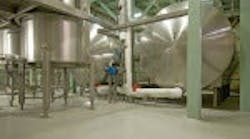Much is demanded of flooring in food processing plants. It must be durable, easy to clean, straightforward to repair and live a reasonably long life. Now, for a growing number of processors, plant flooring also needs to be environmentally friendly.
"We are seeing more and more people asking questions about environmentally friendly flooring in almost every facility [where] we install floors," including food plants, says Dan Kiernan, director of strategic growth for Stonhard (www.stonhard.com), Maple Shade, N.J.
Increasing attention paid to environmental awareness, food safety and employee health – as well as efforts to gain Leadership in Energy and Environmental Design (LEED) certification -- all are driving the green-flooring trend.
In addition, "there are state and federal requirements moving people to lower VOC levels," Kiernan says, referring to volatile organic compounds (VOCs) that pollute indoor air. Plus, plants "are looking for flooring products with longer life cycles and lower maintenance requirements, which are very sustainable building [business] practices."
All Stonhard products are low-VOC and provide environmental benefits, but some of the company's products offer unique green features.
For example, Stonclad GR, an epoxy mortar system, uses recycled glass and rapidly renewable soy-based components. The Stonclad G2 polyurethane mortar system, formulated specially for the food & beverage industry, includes rapidly renewable materials as well as recycled materials. "We can even incorporate waste materials from our customer's waste stream into some of these floors," Kiernan says.
For areas where the floor's aesthetics are important, such as plant offices, Stonhard offers Stonblend GSI-G. This is a decorative, trowel-applied epoxy mortar system that incorporates recycled glass.
Controlling VOCs is a key consideration for The Sherwin-Williams Co. (www.sherwin-williams.com), Cleveland. "As air quality regulations became more stringent, we switched from manufacturing solvent-based systems to offering water-based products, all with VOC levels of 100 grams per liter or lower," says Lonnie Salyers, vice president, technical operations, for Sherwin-Williams' General Polymers brand of flooring systems.
"These low- and no-VOC coatings provide the same — or better — performance than their solvent-based counterparts in delivering thermal shock protection and chemical resistance, two critical issues facing managers of abusive food & beverage facilities. They are especially resistant to disbondment from moisture vapor transmission,"
Salyers adds. Further, "the coatings are greener and thus can contribute to achieving LEED credits for indoor environmental quality."
To meet the flooring needs of constantly wet facilities, such as food processing plants, restaurants and commercial kitchens, Sherwin-Williams offers FasTop 12S. The product is a zero-VOC, water-based urethane concrete that can be used to coat concrete, wood and steel floors.
In addition, Sherwin-Williams offers 4844 PAce-Cote polyaspartic ester coatings. The zero-VOC resin, which can be used as a standalone coating or a top coat on flooring (including concrete) and even on walls, purportedly offers durability and abrasion resistance. The coatings also can stand up to harsh cleaning chemicals, including those used in clean-in-place protocols.
In addition to their green attributes, low- and no-VOC coatings offer the operational benefit of reduced downtime. When an entire floor is being redone with 4844 PAce-Cote, processing lines can return to service four hours after installing the coating. And when using the coating to repair a portion of the floor, the processor can keep lines running without risking product contamination.
Rhino Linings Inc.
Rhino Linings Inc. (www.rhinoliningsindustrial.com), San Diego, also offers polyaspartic technology, in the form of the Rhino Ultra Surface floor coating system. The zero-VOC, hybrid polyurea coating system is decorative as well as durable and offers an environmentally friendly alternative to solvent-based, high-VOC epoxy systems.
In addition to reducing indoor pollution, Rhino Ultra Surface and other liquid systems generate a lower carbon footprint than tile or sheet flooring.
Regarding transportation-related greenhouse gas emissions for liquid coatings vs. solid flooring materials, Ron LoPresto, director of technical at Rhino Industrial, explains,
"A gallon of coating will cover 200 square feet. With tile or linoleum, it would obviously be a heavier 'package.' So the freight to move the linoleum or tile — the fuel used to transport that — would be more than for the one gallon of coating." More fuel translates into more carbon emissions.
A flooring option from QuestMark Flooring, a division of CentiMark Corp. (www.questmarkflooring.com), Canonsburg, Pa., also delivers environmental benefits. The company's DiamondQuest process is used to polish concrete flooring to a smooth sheen.
According to the Eneref Group (www.eneref.org), Doylestown, Pa., a research and advocacy organization that focuses on sustainable building, polished concrete floors can win points for a plant in multiple LEED categories.
One of those categories is Energy and Atmosphere, because the floors' sheen increases ambient light, potentially reducing energy for lighting. Another is the Materials and Resources category, because polishing lengthens the life of existing concrete flooring.
Polished-concrete technology also could conceivably merit points in the LEED Innovation in Design category — and in the Indoor Environmental Quality category, because no VOC products are used.


